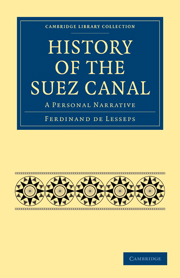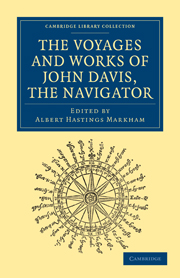Refine search
Actions for selected content:
13588 results in History of science and technology

History of the Suez Canal
- A Personal Narrative
-
- Published online:
- 05 August 2011
- Print publication:
- 24 February 2011
- First published in:
- 1876
‘Stargazers at the world's end’: telescopes, observatories and ‘views’ of empire in the nineteenth-century British Empire
-
- Journal:
- The British Journal for the History of Science / Volume 46 / Issue 3 / September 2013
- Published online by Cambridge University Press:
- 03 August 2011, pp. 389-413
- Print publication:
- September 2013
-
- Article
- Export citation
Making biomedicine in twentieth-century Italy: Domenico Marotta (1886–1974) and the Italian Higher Institute of Health
-
- Journal:
- The British Journal for the History of Science / Volume 44 / Issue 4 / December 2011
- Published online by Cambridge University Press:
- 03 August 2011, pp. 549-574
- Print publication:
- December 2011
-
- Article
- Export citation
Preaching at the British Association for the Advancement of Science: sermons, secularization and the rhetoric of conflict in the 1870s
-
- Journal:
- The British Journal for the History of Science / Volume 45 / Issue 1 / March 2012
- Published online by Cambridge University Press:
- 27 July 2011, pp. 75-95
- Print publication:
- March 2012
-
- Article
- Export citation
Desired Machines: Cinema and the World in Its Own Image
-
- Journal:
- Science in Context / Volume 24 / Issue 3 / September 2011
- Published online by Cambridge University Press:
- 26 July 2011, pp. 329-359
- Print publication:
- September 2011
-
- Article
- Export citation
“The Swarming of Life”: Moving Images, Education, and Views through the Microscope
-
- Journal:
- Science in Context / Volume 24 / Issue 3 / September 2011
- Published online by Cambridge University Press:
- 26 July 2011, pp. 361-380
- Print publication:
- September 2011
-
- Article
- Export citation
Creeping, Drinking, Dying: The Cinematic Portal and the Microscopic World of the Twentieth-Century Cell
-
- Journal:
- Science in Context / Volume 24 / Issue 3 / September 2011
- Published online by Cambridge University Press:
- 26 July 2011, pp. 381-416
- Print publication:
- September 2011
-
- Article
- Export citation
“Tangible as Tissue”: Arnold Gesell, Infant Behavior, and Film Analysis
-
- Journal:
- Science in Context / Volume 24 / Issue 3 / September 2011
- Published online by Cambridge University Press:
- 26 July 2011, pp. 417-442
- Print publication:
- September 2011
-
- Article
- Export citation
SIC volume 24 issue 3 Cover and Front matter
-
- Journal:
- Science in Context / Volume 24 / Issue 3 / September 2011
- Published online by Cambridge University Press:
- 26 July 2011, pp. f1-f3
- Print publication:
- September 2011
-
- Article
-
- You have access
- Export citation
SIC volume 24 issue 3 Cover and Back matter
-
- Journal:
- Science in Context / Volume 24 / Issue 3 / September 2011
- Published online by Cambridge University Press:
- 26 July 2011, pp. b1-b6
- Print publication:
- September 2011
-
- Article
-
- You have access
- Export citation
Science and Cinema
-
- Journal:
- Science in Context / Volume 24 / Issue 3 / September 2011
- Published online by Cambridge University Press:
- 26 July 2011, pp. 311-328
- Print publication:
- September 2011
-
- Article
- Export citation
The Hands of the Projectionist
-
- Journal:
- Science in Context / Volume 24 / Issue 3 / September 2011
- Published online by Cambridge University Press:
- 26 July 2011, pp. 443-464
- Print publication:
- September 2011
-
- Article
- Export citation

Voyages and Works of John Davis, the Navigator
-
- Published online:
- 05 July 2011
- Print publication:
- 31 August 2010
- First published in:
- 1880
The social nature of the mother's tie to her child: John Bowlby's theory of attachment in post-war America
-
- Journal:
- The British Journal for the History of Science / Volume 44 / Issue 3 / September 2011
- Published online by Cambridge University Press:
- 06 June 2011, pp. 401-426
- Print publication:
- September 2011
-
- Article
- Export citation
Kristian Camilleri, Heisenberg and the Interpretation of Quantum Mechanics: The Physicist as Philosopher. Cambridge: Cambridge University Press, 2009. Pp. xii+199. ISBN 978-0-521-88484-6. £45.00 (hardback). - Cathryn Carson, Heisenberg in the Atomic Age: Science and the Public Sphere. Cambridge: Cambridge University Press, 2010. Pp. xxiv+541. ISBN 978-0-521-82170-4. £55.00 (hardback).
-
- Journal:
- The British Journal for the History of Science / Volume 44 / Issue 2 / June 2011
- Published online by Cambridge University Press:
- 27 May 2011, pp. 308-309
- Print publication:
- June 2011
-
- Article
- Export citation
Ian Hesketh, Of Apes and Ancestors: Evolution, Christianity and the Oxford Debate. Toronto: University of Toronto Press, 2009. Pp. viii+144. ISBN 978-0-8020-9284-7. CDN$29.95 (hardback).
-
- Journal:
- The British Journal for the History of Science / Volume 44 / Issue 2 / June 2011
- Published online by Cambridge University Press:
- 27 May 2011, pp. 298-300
- Print publication:
- June 2011
-
- Article
- Export citation
Richard Moore, Nuclear Illusion, Nuclear Reality: Britain, the United States and Nuclear Weapons 1958–64. Basingstoke: Palgrave Macmillan, 2010. Pp. xvi+332. ISBN 978-0-230-23067-5. £65.00 (hardback).
-
- Journal:
- The British Journal for the History of Science / Volume 44 / Issue 2 / June 2011
- Published online by Cambridge University Press:
- 27 May 2011, pp. 309-311
- Print publication:
- June 2011
-
- Article
- Export citation
Florike Egmond, The World of Carolus Clusius: Natural History in the Making 1550–1610. London: Pickering and Chatto, 2010. Pp. xiv+292. ISBN 978-1-84893-008-7. £60.00 (hardback).
-
- Journal:
- The British Journal for the History of Science / Volume 44 / Issue 2 / June 2011
- Published online by Cambridge University Press:
- 27 May 2011, pp. 286-287
- Print publication:
- June 2011
-
- Article
- Export citation
Ole Peter Grell, Andrew Cunningham and Jon Arrizabalaga (eds.), Centres of Medical Excellence? Medical Travel and Education in Europe, 1500–1789. Farnham: Ashgate, 2010. Pp. xvi+335. ISBN 978-0-7546-6699-8. £60.00 (hardback).
-
- Journal:
- The British Journal for the History of Science / Volume 44 / Issue 2 / June 2011
- Published online by Cambridge University Press:
- 27 May 2011, pp. 283-284
- Print publication:
- June 2011
-
- Article
- Export citation
Anthony Gerbino and Stephen Johnston, with a contribution by Gordon Higgott, Compass and Rule: Architecture as Mathematical Practice in England, 1500–1750. New Haven and London: Yale University Press, 2009. Pp. 207. ISBN 978-0-300-15093-3. £30.00 (hardback).
-
- Journal:
- The British Journal for the History of Science / Volume 44 / Issue 2 / June 2011
- Published online by Cambridge University Press:
- 27 May 2011, pp. 287-289
- Print publication:
- June 2011
-
- Article
- Export citation
